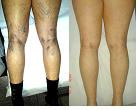
Leonardo Corcos
Founding Member and Vice president of the Italian Society of Phlebolymphology. University of Siena Sassari and Udine (1990-2010)
Title: Recurrent Skin Telangiectasia
Biography
Biography: Leonardo Corcos
Abstract
Primary and secondary skin telangectasia (ST) are mainly a cosmetic problem, they can be extended to the whole body but he majority of them develop in the lower limbs. They are one of the most difficult challenges in vascular and cosmetic Medecine owing to a high number of early and late recurrences post-treatment and progressive trend. The aim of the study was to identify and treat the main anatomical and functional causes. Patients were systematically subjected to duplex venous ultrasound examination. Chronic venous insufficiency and reticular varicose veins were investigated. In 467/529 cases (88.2%) recurrent telangiectasia of various anatomical types were found. The main causes as chronic venous insufficiency and/or reticular varicose veins were preventively treated. The majority of ST were treated by liquid sclerotherapy and a small number of red ST were treated by 808 nm diode surface or endovascular laser. The treatment was guided both by transillumination and polarized light. Immediate elastic compression with refrigerant padding was applied. Only 271 (51.29%) patients were controlled from 1 to 10 years (mean follow-up 6 years, 8 months) and retrospectively studied from 2002 up to 2012. ST were combined with truncular varicose veins in 22 cases (4.1%). Persistence of reticular varicose veins in the 92.2% of the cases, atypical perforators in the 13.6%, were the main anatomical causes of recurrence. Inadequate or uncomplete treatment limited to peripheral ST was observed in the majority. Stable results in 23/271 cases (8.4%), a progressive trend and essential recurreces in 45/271 (16.9%), worsening in 4/271 cases (1.4%) were observed. Improvement of the clinical and cosmetic outcome can be obtained by etiological treatment with the use of new tecnology of light sources and refrigerant elastic compression.

Recent Publications
1. Corcos L, Longo L. Classification and treatment of telangiectases of the lower limbs. Laser. The Official Journal of the European Medical Laser Association. 1988; 1,3:22-28.

